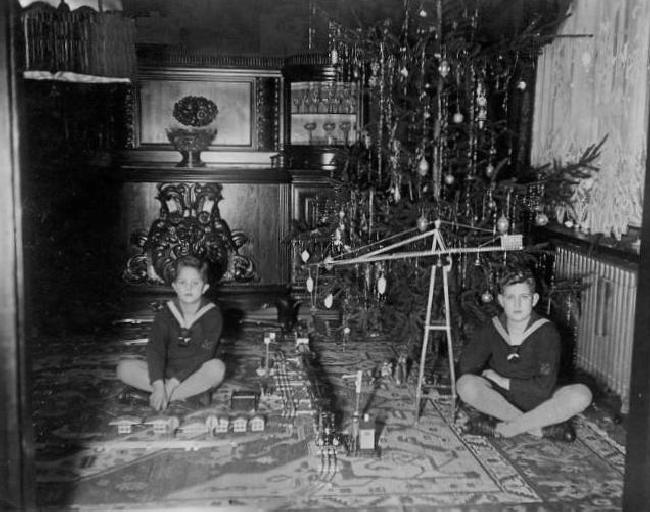
Unidentified German Brithers: Christmas Train Layout (1929)

Figure 1.--These German brothers in 1929 wear identical short pants sailor suits. Note how their long stockings, probanly tan or grey, do not match their suits. The boys have set up their very orderly model train layout in the living room in front of the Christmas tree. Notice ther three rails which were how electric trains were done at the time. Like most German boys they did not have a permaent lay out. They look to be about 10-13 years old.
|
|
These unidentified German brothers in 1929 wear identical short pants sailor suits. Note how their long stockings, probanly tan or grey, do not match their suits. The boys have set up their very orderly model train layout in the living room in front of the Christmas tree. Notice ther three rails which were how electric trains were done at the time. Like most German boys they did not have a permaent lay out. They look to be about 10-13 years old.
The Boys
These unidentified German brothers in 1929 were photographed in the family living room with the Christmas tree. They look to be about 10-13 years old. Unfortunately there was no information attached to the family snapshot, except the date. It provides us an interesting look at the family living room decorated for Christmas. We would say that this was a middle-class family.
Clothing
Sailor suits were still popular boys wear in the 1920s. We see pre-teen boys commonly wearing them as well as younger teenasgers. They were woirn both as casual wear as well as for dressing up, which was probably the case here. Sailor suits were especially common with middle-class families. The boys wear identical short pants sailor suits. Note how their long stockings, probanly tan or grey, do not match their suits. The tan long stockings for boys were already becoming popular in Germany during the 1920s. I have found other examples worn with sailor suits. Here is another unidentified German boy wearing his sailor suit with light-colored long stockings.
Electric Train
Unfortunsately the snapshot is not clear enough to make out much detail about the boys' electric engine. We can not tell much about the engine. Presumably it was a model coimmonly in use on Germany's estensive railroad system. We seem to see several open box cars. The train set is electric. Notice the three rails which were how electric trains were done at the time. After World War II, the model rail road companies began converting to the more realistic two rail system.
Layout
It may be that the boys had no permanent lay out. The boys have set up their very orderly model train layout in the living room in front of the Christmas tree. Like most German boys they did not have a permaent lay out. The main layout is an oval with one side tack. There do not seem to be asny cross tracks. A reader writes, "This family might have had a permanent layout later. It is Christmas time so it might be that they layed out the train to show the gifts they had got for the photograph. This is in the picture too. Lucky boys." A reader writes about the image, "I'm curious about the older boy's toy. The ten-year-old seems to have received the model train as his Christmas present, but the thirteen-year-old has something different. It looks like some sort of revolving gadget on a pedestal. Is this like an American erector set which allows a boy to build his own construction? It occurs to me that the revolving part (horizontal to the tower) has some sort of unit mounted on it (a light? a whistle?). Could this be a toy version of a revolving airport light that is electrically powered? Perhaps our German readers will have some notion of just what this toy actually does." The toy is a crane which the boys used to load and unload the train cars. It is clearly not a erector set construction, the pieces look like metal tubing that had been wielded together. Our guess is that it is mannual because we do not see any electric cord. Another reader writes, "I think the crane was a construction kit which fitted together. The pieces slotted into the bases at the various section. There is a working pully system from the cab on the top platform. I think there was a handle here to turn so the hook could be raised and lowered. If it was the 13-year old's present then it is quite possible that the construction set could be dismantled and made into a variety of models. They undoubtedly had a marvelious Christmas."
HBC

Navigate the Boys' Historical Clothing Web Site:
[Return to Main German electric train layout page]
[Return to Main German toy type page]
[Return to Main toy train country page]
[Return to Main railroad page]
[Introduction]
[Activities]
[Biographies]
[Chronology]
[Clothing styles]
[Countries]
[Bibliographies]
[Contributions]
[FAQs]
[Glossaries]
[Tools]
[
Boys' Clothing Home]
Created: 8:47 PM 2/15/2010
Last updated: 8:47 PM 2/15/2010



